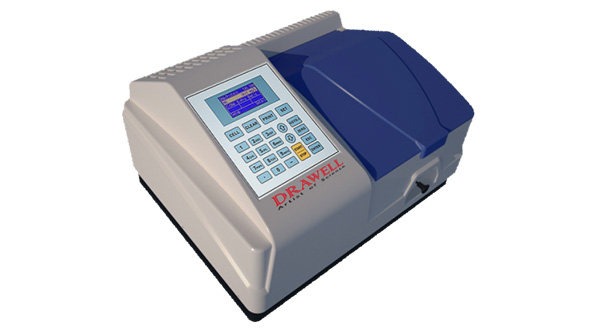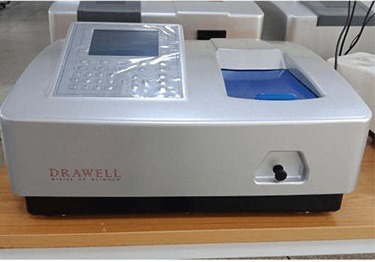A form of UV spectrophotometer is the UV vis spectrophotometer. It is an analytical equipment based on the principle of ultraviolet-visible spectrophotometry, which analyses the absorption of radiation in the ultraviolet-visible spectrum using material molecules. The light source, monochromator, absorption cell, detector, and signal processor are the primary components. The light source's function is to provide a stable continuous spectrum of suitable intensity.
A hydrogen lamp or a deuterium lamp is typically used in the ultraviolet light zone. A tungsten or halogen lamp is typically used in the visible light zone.
The monochromator's function is to separate the monochromatic light of the desired wavelength from the composite light emitted by the light source.
Dispersive elements are classified into two types: prisms and gratings. A glass absorption cell is used for visible light measurements, and a quartz absorption cell is used for UV measurements.
The detector detects the intensity of the transmitted light using a photoelectric conversion element and converts the light signal into an electrical signal. Phototubes, photomultiplier tubes, and photodiode array detectors are common photoelectric conversion elements.
There are numerous spectrophotometer categorization methods: It is classified into single-beam ultraviolet-visible spectrophotometers and dual-beam ultraviolet-visible spectrophotometers based on the optical path system. It is classified into single-wavelength and dual-wavelength spectrophotometers based on the measurement method. The detection method of producing the spectrogram can be classified as spectrum scanning detection or diode array full spectrum detection.

What is the operation of the UV-Vis spectrophotometer?
The molecule's ultraviolet-visible absorption spectrum is the absorption spectrum created by the electronic energy level transition after some groups in the molecule absorb ultraviolet-visible radiation.
Because different chemicals in the analyte have distinct molecules, atoms, and molecular spatial configurations, their absorption of light energy will change. Spectrophotometric analysis is a powerful tool for investigating the composition, structure, and interaction of substances using their absorption spectra. It is a band-shaped spectrum that reflects information from different groups in the molecule. For qualitative investigation, the conventional light spectrum can be complemented with various methods.
Lambert-Beer's law states that light absorption is proportional to the thickness of the absorption layer, and Beer's law states that light absorption is proportional to the solution concentration; Lambert-Beer's law holds true when both the thickness of the absorption layer and the influence of the solution concentration on the light absorption rate are taken into account. That example, if A=bc (A is the absorbance, is the molar absorption coefficient, b is the liquid pool thickness, and c is the solution concentration), then the solution can be quantitatively analysed. The analytical and control samples are produced in the same solvent at the same concentration, and the ultraviolet-visible absorption spectra are analysed independently under the same conditions. If they are the same substance, their spectra should be the same. If no standard sample is available, it can be compared to a ready-made standard spectrum control.
What is the structure and function of the UV-Vis spectrophotometer?
The UV-Vis spectrophotometer is composed of five parts: light source, monochromator, absorption cell, detector, and signal display system. Light source: A device that produces incident light that meets the specifications. Heat radiation light sources and gas-discharge light sources are the two categories. Thermal radiation light sources, such as tungsten lamps and tungsten halogen lamps, are used in the visible light region, with a wavelength range of 3501000nm; gas-discharge light sources, such as hydrogen and deuterium lamps, are used in the ultraviolet region, with a continuous wavelength range of 180360nm.
The function of a monochromator is to isolate the needed monochromatic light beam from the composite light created by the light source. It is the spectrophotometer's brain.
A cuvette is another name for an absorption cell. Its purpose is to determine the absorbance of the test solution. It has ground glass on the bottom and two sides, and optically clear surfaces on the other two sides. The optical surface of the absorption cell must be complete in order to limit light reflection loss. Perpendicular to the direction of the beam. It can be separated into glass cells and quartz cells based on the material. The former is used to measure the visible light region, whereas the latter is used to measure the ultraviolet light zone.
Detector: An optical signal converter that converts optical signals to electrical signals. Instead of directly detecting the intensity of light flowing through the absorption cell when measuring absorbance, it turns the intensity of light into a current signal for testing. A detector is a photoelectric conversion device.
Signal display system: A device that amplifies and displays the signal emitted by the detector.
What are the features and benefits of the UV vis spectrophotometer
Sensitivity is really high.
Excellent selectivity.
High precision.
Widespread use.
Use a variety of concentrations.
The expense of the analysis is little.
Simple to use.
The analysis is completed quickly.

How to choose a high-quality UV-Vis spectrometer is an important topic in the laboratory because it is an important laboratory tool. I'd like to suggest the UV-ViS spectrophotometer from DRAWELL to you. It can provide you with high-quality spectrometers as a professional spectrometer manufacturer. The UV-Vis spectrophotometer from DRAWELL is classified as a single beam spectrophotometer or a double beam spectrophotometer based on the instrument structure, and as a visible spectrophotometer or an ultraviolet spectrophotometer based on the wavelength and atmosphere of the absorbed light. If you have any questions about DRAWELL or UV-Vis Spectrometer, please contact us, and our engineers will offer you with high-quality technical assistance.











Comments (0)